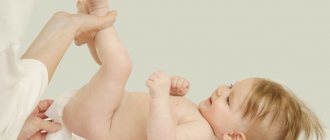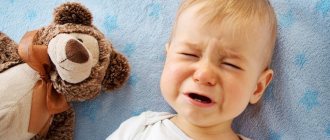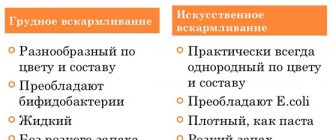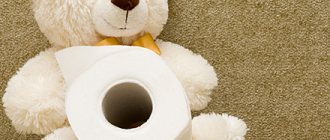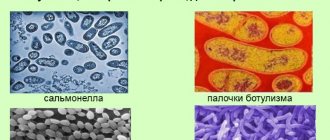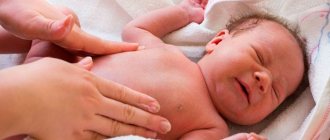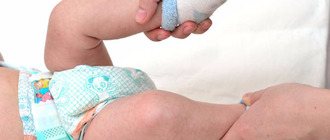Normal stool in a baby
Interest in baby feces among those who do not have children is usually considered something abnormal and strange. In fact, there is nothing wrong with this. You can collect an anamnesis from an adult: he will show what hurts him, talk about his feelings. A child can't do that. Therefore, parents must pay attention to the well-being of their child.
Everything is important: how he breathes, how he moves his arms and legs, what color the whites of his eyes are. There are also more familiar signs: nasal congestion, fever, redness of the mucous tissue in the throat. It is also necessary to monitor what ends up in the diaper. For example, if a child poops with foam, his gastrointestinal tract is definitely not working properly.
First you need to find out what the norm should be. Baby feces in babies under one year old who are breastfed can look like this:
- Meconium. Dark green, brown, black. Very dense, viscous, difficult to wash off. Happens in the first three days after birth. This is the so-called original feces, that is, the one that formed in the intestines before birth.
- Light gray or gray-green, pasty. "Transitional" cal. Appears towards the end of the first week of life.
- The stool ranges in color from yellow to brown. Moderately thin, may contain some white lumps, a small amount of mucus or some green matter. The smell is fermented milk, but not sharp. Frequency - from 4 to 12 times a day (depending on age, in children on IV - less often than on HF). May be combined with the release of gases from the intestines. This is the normal amount of feces for a breastfeeding child before complementary feeding is introduced, if he is gaining weight well.
- The stool is greenish in color, pasty or moderately liquid. The baby does not show any anxiety. Variant of the norm when introducing complementary foods.
- Other unusual colors, fragments of undigested food. If the baby is calm, this is the norm when introducing food other than milk.
Important! In all other options, parents should pay attention - something is going wrong. Need specialist advice. With the above norm, if the child is restless, has increased gas production (except during the period of infant colic), and has a stomach ache, you should also consult a doctor.
Mom and baby at the doctor
Treatment of diarrhea in a child
To prescribe the correct treatment regimen, the child must be examined by a doctor. After collecting anamnesis, studying all dietary habits and habits, the pediatrician prescribes a laboratory test of stool for the presence of hidden blood inclusions and opportunistic microflora. For a more accurate diagnosis, the following is prescribed:
- malabsorption tests;
- serological studies;
- sweat test;
- provocative tests to identify the allergen.
The diagnosis of dysbacteriosis is made by a doctor. Therapy includes treatment with drugs containing lacto and bifidobacteria to normalize the microflora.
Drug treatment
In addition to saturating the body with beneficial microflora, signs of intoxication should be eliminated and harmful bacteria should be eliminated.
Mobile bacteria Campylobacter, the causative agent of infection
For this purpose, adhere to the following algorithm of actions:
- saline solutions (“Regidron”, “Glucosan”, “Oralit”, “Gastrolit”);
- glucose solution diluted in water - for drinking;
- preparations with paracetamol to reduce high fever (suppositories, syrups);
- sorbents (“Smecta”, “Microsorb-P”, “Activated carbon”, “Filtrum”, “Enterodez”);
- symptomatic drugs for diarrhea (“Diarol”, “Bismuth”);
- intestinal antiseptics (“Kanamycin”, “Gentamicin”, “Polimexin”, “Furazolidone”);
- enzymes (“Mezim forte”, “Pancreatin”, “Pangrol”);
- probiotics (“Bifidum baby”, “Bifidumbacterin”, “Enterol”, “Hilak forte”);
- antibacterial drugs;
- antihistamines;
- antispasmodics (“Papaverine”);
- antibiotics (“Furazolidone”, “Nevigramon”) - if the doctor considers it appropriate.
During illness, it is necessary to more carefully monitor the replenishment of the water balance. Also, in order to eliminate the burden on the inflamed digestive system and liver, the baby is provided with dietary nutrition.
Dietary recommendations
- smoked, salted, fatty, fried foods - exclude completely;
- prepare pureed soups, rice water, porridge with water;
- Stewed vegetables and fruits from compotes are allowed;
- you should often offer water, decoctions, compote;
- in the first days of illness, it is recommended not to offer fermented milk products;
- After the diarrhea can be stopped and the condition stabilized, the child can be offered crackers and sweet tea.
Traditional treatment
Alternative medicine has proven itself well and can indeed be an auxiliary method of combating loose, foamy stools in a child, but when symptoms appear in infants, you should not waste time on herbal treatment.
Typically, medications have a cumulative effect. In order not to bring the body to dehydration, you should entrust your fate to doctors of conservative medicine, and only after the danger is left behind, to restore the mucous membranes of the digestive system, can the following be used:
- Rose hip.
- Chamomile.
- Yarrow.
- St. John's wort.
Herbal remedies are not as safe as they may seem, therefore, additional traditional methods should be discussed with your doctor. Mothers should closely monitor changes in the baby's condition. If a child has foam instead of feces, then this is not the best moment for experiments, since the symptom indicates a rapid loss of water by the body and the aggressive actions of an intestinal infection. Even if a child has diarrhea with foam, without fever, you should not self-medicate.
What is foamy stool like?
Loose stools in a breastfed baby
If the consistency of the stool changes and your baby poops foam, this is a sign that something is wrong. For some reason, the fermentation process begins in the intestines. Mom and dad should not ignore this symptom.
Yellow and green
If the baby develops yellow foam in his stool once, and the baby does not show signs of dissatisfaction, then this is acceptable. The gastrointestinal tract of a small person is just learning to work. Therefore, the appearance of bubbles is a variant of the norm if it lasts one day, maximum two. If this happens often, you need to contact your pediatrician.
If a baby poops green foam, this can also be a variant of the norm, only if nothing bothers the child, says pediatrician Komarovsky. If he is gaining weight well, does not suffer from tummy pain, and only poops foam once or a few times, there is no problem. Then you should do a massage, apply a heating pad - everything, as with colic.
Evgeny Komarovsky
If foam appears in the baby’s stool along with pain, discomfort, a strong unpleasant odor, and inflammation is visible on the skin near the anus, something is going wrong. The stool may foam due to fermentation in the gastrointestinal tract; green color indicates indigestion of food.
With mucus
Mucus in a baby's stool may appear for the following reasons:
- Allergy;
- Teething period;
- Enzyme deficiency;
- Predominance of sweet foremilk in the diet;
- Infection.
This symptom is not considered a deviation from the norm if there is little mucus in the child’s stool, or when the child has increased salivation due to the active growth of teeth (saliva flows into the stomach and becomes mucus). In other cases, this indicates serious problems, especially if the baby poops foam along with mucus.
Reasons for stool changes
There are many of them. Children's doctors identify the most common factors that provoke alarming changes. Here are the main reasons for foamy stool in infants:
- Allergy. It even occurs with breast milk. Let us remind you: the products consumed by the mother (all without exception) end up in it. However, not all such components of milk are normally perceived by the baby’s digestive system. When a child is prone to allergies, his gastrointestinal system reacts to similar products on the mother’s menu with a kind of protest - the baby poops foam. A similar reaction of the ventricle can be observed with the illiterate introduction of adult food (complementary foods). We are talking about introducing the baby to them too early or not following the principle of gradualness when introducing them.
- Medicines. Even medications allowed for such young patients can provoke a sharp deterioration in digestion. A manifestation of this is that the child has foam instead of feces. Also, the use of medications by the mother of the baby provokes a similar condition. Inexperienced lactating women, when they experience pain (dental, stomach), out of habit, grab medications from the home medicine cabinet, not taking into account that they quickly penetrate into their milk. Experience shows that even specially designed anti-colic medications for infants can cause foamy diarrhea in a child.
- Infections. Intestinal diseases quite often provoke the above problems if parents themselves ignore the rules of hygiene and do not pay due attention to sterility in keeping the baby. In such situations, not only does the child develop foam in the stool, but the body temperature rises sharply, colic occurs, and the child cries restlessly. Pediatric practice states that rotavirus in infants can also be the cause of watery, foamy stools. In the latter case, the feces become green. Infections can also cause digestive disorders during periods of teething in children of this age. This is always a painful process when babies try to scratch their sore gums and pull various dirty toys and objects into their mouths. Thus, infectious agents provoke foamy stool in an infant. In addition, salivation may increase and the child may experience irritability.
- Dysbacteriosis. It is not a common factor that a baby develops loose stools with foam. The disease is almost always accompanied by disruptions in the functioning of the child’s weak digestive system. A characteristic feature in this case is undigested food in the feces, weight loss with a good appetite. Children's doctors claim that in some newborns, transit dysbiosis can be a temporary phenomenon and does not require drug interventions or other auxiliary measures.
- Lactase deficiency is nothing more than the presence of a deficiency of a particular enzyme. Lactase is a substance that helps babies process food. They receive the enzyme through mother's milk. When a woman doesn’t have enough of it, her child’s feces take on a different, more unpleasant smell. Bubbles and foam are observed in the child's stool.
- Incorrect feeding technique. An imbalance of breast milk occurs when the baby simply does not get the so-called hind milk, which is more nutritious. Getting a purely anterior one, the child may experience loose, foamy stools. This is more common in cases where the mother is inexperienced and incorrectly applies the baby to the mammary glands. This is what provokes foamy stool in the baby during the guard.
- Malnutrition. Breast milk deficiency catalyzes not only a lack of enzymes, but also weight loss and disruptions in the baby’s digestive tract. This is also reflected in the condition of the feces. It may become lighter, almost white.
- Excessive gas formation. This is often typical for babies up to three months of age, during the formation of their gastrointestinal tract. Sometimes the problem goes away without the intervention of a pediatrician, with age. But often gas formation and its consequence - foam in the stool of a baby - is the result of a woman’s illiterate nutrition. Eating cow's milk, stewed cabbage, sweets, grapes and other forbidden dishes on the menu has a negative impact on the child's digestion.
- Intolerance to certain foods. Some infants may develop celiac disease when introduced to cereal-based complementary foods. Then the feces become smelly and even shiny.
- Cystic fibrosis. This is the name for disruption of the functioning of the endocrine system of congenital etiology. The pathology manifests itself as disturbances in the gastrointestinal tract, weight loss, and diarrhea.
- Other ailments. Foamy stool in a baby can be just one of the signs of volvulus, peritonitis or appendicitis. Diseases such as the causes of bowel problems are not often recorded in young patients. Only experienced pediatric doctors can diagnose them in such a case.
Why does foam appear?
Stool in newborns during breastfeeding
The fermentation process in the intestines can begin for various reasons. Every young parent needs to know them.
Infectious diseases
When an intestinal infection occurs, the bacterial balance of the gastrointestinal tract is seriously disrupted. The result is green stool with foam in the baby, most often with admixtures of mucus or even blood. The baby is restless at this time, eats and sleeps poorly. As a rule, this condition is accompanied by an increase in temperature. The most striking example of such an infection is rotavirus, or intestinal flu.
Influenza virus
Note! This condition is very dangerous. If you suspect an intestinal infection in an infant under one year old, you should definitely call a doctor. If your temperature rises, this is a reason to immediately call an ambulance. The same thing happens if there is feces mixed with streaks of blood.
Lactase deficiency
Lactase is an enzyme that helps digest milk. Its deficiency leads to the fact that the only food a breast-fed baby receives is poorly absorbed by the body. Digestion is accompanied by pain and bloating. The child suffers from intestinal colic. The baby develops foamy stools with an unpleasant, pungent odor. It may also contain mucus. Suspicion of lactase deficiency is not a reason for emergency care. You should contact your treating pediatrician as soon as possible.
Dysbacteriosis
The gastrointestinal tract of a newborn baby is sterile. It does not contain the necessary microflora that is responsible for the proper breakdown of food. The intestines and stomach begin to be populated with beneficial bacteria only with the first drops of mother's milk. The most critical period of this time is the first 3 months on average.
The baby's microflora is very vulnerable. Many children under the age of one year are diagnosed with dysbiosis - an imbalance of beneficial bacteria. For example, a baby usually poops foam when the level of Staphylococcus aureus is elevated. Normally, this bacterium is present in the gastrointestinal tract, but when there is too much of it, it leads to discomfort.
Among the possible causes of dysbiosis is a complication after taking strong medications, for example, antibiotics. It is to avoid the development of such a problem that it is recommended to give a probiotic along with the antibiotic.
Biogaya is a children's probiotic popular among Russian mothers.
Early complementary feeding
According to WHO recommendations, only 4-month-old babies (most often these are bottle-fed babies) can be given the first complementary foods, not earlier. It’s better to wait until six months, but even here you need to look at the child’s readiness. If after the first feeding the baby has foamy stools, it is better to put off the puree or porridge and consult a doctor.
Predominance of foremilk in the diet
Experienced breastfeeding mothers know that milk comes in different forms:
- Front;
- Rear.
These names are given because milk is produced in different parts of the glands: the anterior and posterior. Starting to get full, the baby first of all eats what is closest, that is, foremilk. It is rich in sugars.
Normally, a baby needs both foremilk, which is sweet, and hindmilk, which is richer in fat. In mothers with hyperlactation, it happens that the baby simply does not reach the hind milk, being saturated with the fore milk. A large amount of milk sugar also causes severe bloating and fermentation in the intestines, which causes foamy stool.
External differences between types of breast milk
Mom's poor diet
There is an opinion that a mother can eat anything while on guard duty. But you need to approach everything wisely, knowing when to stop. If a parent eats too much chocolate, legumes, smoked meats, or fresh vegetables, then her child may then suffer from bloating and, as a result, foamy feces.
Celiac disease
To put it simply, it is gluten intolerance. Foam in the baby’s stool may also appear with it. This problem usually arises already in the second half of the baby’s life, when porridge is introduced into his diet.
Foamy chair – when should you worry?
In some cases, foamy stools can be a warning sign indicating serious illness. To differentiate the norm from a possible pathology, it is necessary to assess the child’s condition and monitor his well-being.
Normal stool in a baby
Infectious inflammation of the intestines
Intestinal infections in children of the first year of life are quite common. In most cases, acute infection occurs in children over 6 months of age receiving complementary foods. The causative agent of infection can be contained in poorly processed and stale meat, fish, eggs, and cottage cheese. Failure to maintain hygiene of hands and toys can also cause infection to enter the child’s digestive tract, so it is important to regularly carry out wet cleaning and disinfection of the surrounding area.
It is especially necessary to monitor the cleanliness of objects that the child constantly puts in his mouth: pacifiers, pacifiers, rodents, teethers. They must be washed with soap and hot water after each use, and are best stored in a plastic bag (rodents and teethers can be put in the refrigerator).
Intestinal infection in children
The main symptom of any intestinal infection is diarrhea. Stools with diarrhea may be watery or foamy. Foamy feces are more often observed with salmonellosis and dysentery. Some viral infections caused by rotaviruses and enteroviruses may also cause loose, foamy stools. Feces have a foul, pungent odor and may contain streaks of mucus, drops of blood and particles of undigested food. In addition, the child also exhibits other signs:
- vomiting (usually profuse, repeated, not bringing relief);
- refusal to eat;
- pale skin;
- dry lips and oral mucous membranes (caused by dehydration);
- high temperature (can rise to 40°).
Important! Treatment of intestinal infections in children of the first year of life should be carried out in a hospital setting, since children of this age group are at increased risk of mortality. At home, the child needs plenty of fluids (1 teaspoon every 10 minutes) and food rest (fasting). Before the doctors arrive, you can give your baby any enterosorbent (Smecta, Polysorb, Enterosgel). In case of severe vomiting, you can give Motilium syrup - its dosage is determined by the child’s weight and measured using the dispenser syringe included in the package.
Motilium suspension for children
Infection with worms
Helminthiases in infants are quite common. The main cause of infection with worms is non-compliance with personal hygiene and rules for sanitizing the surrounding area. If there are pets in the house, they can also be a source of helminthiasis, so treatment with anthelmintic drugs must be carried out at least 2 times a year. It is important to monitor your child’s behavior outside: many worms live in contaminated soil, sand, and water. There are especially many worms in puddles, in which children of any age love to play.
Acute helminthiasis is manifested by quite characteristic symptoms, which may include:
- thick, foamy stool with a pungent odor;
- irritation in the anal area (especially common with enterobiasis);
- vomiting and excessive regurgitation;
- increase in temperature within the subfebrile range;
- pale skin;
- skin rash.
Danger of helminth infection
If the disease becomes chronic, the symptoms disappear, and the only manifestations of the pathology may be abdominal pain, intestinal colic, and spasms accompanied by tension in the abdominal muscles. Almost always, chronic helminthiasis is accompanied by abnormal stool: stool can be liquid, watery, and may contain foam and mucus.
The choice of drugs for the treatment of helminthic infestation in children of the first year of life should be made by the attending physician, since they have a high degree of toxicity and negatively affect the functions of the hepatocytes that make up the liver tissue. Some of the medications in this group are allowed to be taken only from a certain age, so before giving your baby medicine for worms, you should consult your doctor.
List of drugs for the treatment of helminthiasis in children of the first year of life
| Name of the medicine and release form | Image | At what age can it be given? | Dosage regimen |
| Suspension "Pyrantel" | From 6 months | 125 mg once during or immediately after feeding. For infestations caused by hookworms, the drug is prescribed for 3 days at a dosage of 10 mg per kilogram of the child’s weight | |
| Suspension "Helmintox" | Approved for use in children whose weight exceeds 12 kg. | 1 scoop of suspension (12.5 ml) for every 10 kg of child’s weight once | |
| Suspension "Nemotsid" | From 10 months | 125 mg once during feeding |
Video - Baby stool: what is normal and what is not
Diagnostic methods
Green stool in a formula-fed baby
You can determine that everything is definitely not okay with the baby using the following points:
- The stool is liquid or watery, foamy. At the same time, the diarrhea has a sharp and bad smell. Color varies from yellow to green.
- There may be impurities: mucus or blood.
- The child feels unwell. He is bothered by cramps in his tummy, he bends his legs to his stomach, strains, farts, and cries. The clinical picture may be similar to that of colic.
- The situation repeats for more than two days in a row.
- The baby is not gaining weight well and looks unhealthy.
- The skin around the anus may be inflamed.
If your child's stool starts to bubble, there is probably already some problem. Depending on the severity of the child’s condition, you either need to visit your local pediatrician or call an ambulance. In case of high body temperature, vomiting, or blood in the stool, you should immediately call an ambulance.
Mom calls an ambulance
Prevention
Foamy stool in a child is a serious symptom that should not be ignored. If the cause is not related to overeating, then it can be so serious that hospitalization cannot be avoided. It is worth noting that by following some mandatory rules, diarrhea with foam and foul odor can be avoided. This is why you should:
- Observe the rules of personal hygiene and teach your child to them from an early age.
- Products such as eggs, milk, fish must be processed thermally.
- It is recommended that children cook food only using gentle methods (oven, steamer, multicooker).
- All vegetables, fruits, and citrus fruits should be washed before eating.
- You should not drink raw tap water; you should stock up on bottled water and use a filter.
- Monitor the expiration dates of the food you buy and do not buy fermented milk products with expiration dates on the packaging.
- After contact with animals, walking outside, before eating, you must remember to wash your hands.
- The well-being of breastfed children depends on the hygiene and diet of the mother.
- Loose stools with foam in a baby can be caused by the mother's erratic diet - pediatricians recommend adhering to a special diet.
- The approach to introducing complementary foods should be conscious and competent.
- For artificial feeding, it is worth choosing mixtures with probiotics and vitamin complexes.
- The habit of licking the baby's pacifier and spoon by adult family members should be eradicated.
- It is necessary to pay attention to the formation of barrier functions of the body.
- Create a favorable psycho-emotional environment, as stress weakens the immune system.
- Avoid polluted beaches and public bathing areas.
By following basic rules, you can significantly reduce the risk of foamy diarrhea in a child with a foul odor.
Prevention is not a guarantee, since diarrhea of infectious origin can occur through contact with sick children. Most often, foamy stool occurs in a child at the age of 2, when he learns about the world in more detail, attends kindergarten, and plays in common sandboxes.
What parents need to do
It is mom and dad who are primarily responsible for the life and health of their baby. Therefore, they should know how to help a child when he feels bad. This can be done like this:
- If a newborn poops foam, and this is accompanied by other dangerous syndromes, you should immediately seek emergency medical help.
- Mom needs to reconsider her diet. Maybe she ate too many bloating foods. In this case, adjusting the diet will solve the problem.
- It is necessary to assess whether the child is ready to eat “adult” food. Many parents can’t wait to switch their children to cereals and purees. There is no need to rush into this. It is better to allow the baby's intestines to mature for this.
- If the mother has too much milk, she should change breasts less often during feedings. Usually give one per feeding. In case of hyperlactation, one breast is given for two feedings. So the baby eats both fore and hind milk.
- When treating with antibiotics, be sure to give probiotics for a small belly along with them.
- Lactase deficiency is a problem that must be treated by a doctor. Self-medication is unacceptable.
Foamy poop in a baby is a symptom that parents should not ignore. Maybe the solution will be to adjust the mother’s diet, maybe the problem is more serious and requires drug treatment. In any case, if any controversial issues arise, you should consult a doctor.
Foamy stool: treatment
When treated with antibiotics, the drugs Lactiale or Lactovit are prescribed. For bacterial ailments that are associated with infection with staphylococcus or other bacteria, antibiotics are prescribed, which are also combined with drugs containing lacto and bifidobacteria. Sometimes Bifidumbacterin is prescribed along with them.
Foamy stools, treatment:
- If foamy stool is observed in an infant due to an insufficient amount of enzymes and beneficial microorganisms that help digest food, Bio-Gaia drops are prescribed. These are bifidobacteria that help improve the functioning of the stomach and populate it with beneficial microorganisms. They can also prescribe Bifidumbacterin, Laktiale, Linex.
- Such drugs are prescribed even to infants. If foamy stools are caused by complementary foods, the introduction of new foods is postponed for some time. Nothing bad will happen if you introduce a new product not in a week, but in two. A child's reaction may be unpredictable to a particular product. Indigestion is often caused by potatoes.
- It contains a lot of starch and, in general, is quite heavy for a child’s body. Foamy stools are a reaction to apricot and pear puree. These are healthy fruits, but they can also put a serious strain on your baby's stomach. Under no circumstances should you give adult foods from your table when introducing complementary foods. The child's stomach is not ready to digest such food.
Baby
Temperature and foamy stools in a child - what to do?
If foamy stool is accompanied by vomiting, diarrhea, and the child has a fever, malaise, or weakness, then be sure to show it to a doctor and do not self-medicate.
Temperature and foamy stools in a child, what to do:
- In each specific case, after receiving the test results, the doctor will prescribe the necessary treatment.
- Under no circumstances should antibiotics be given for such a symptom. They may not only not help, but will make the situation even worse.
- Give the child water. If he vomits, give it with a syringe or spoon.
Abdominal pain
Treatment of foamy stools depends on the cause that triggered its occurrence. If it is viral enterocolitis, then antiviral drugs such as Groprinosin are prescribed.
